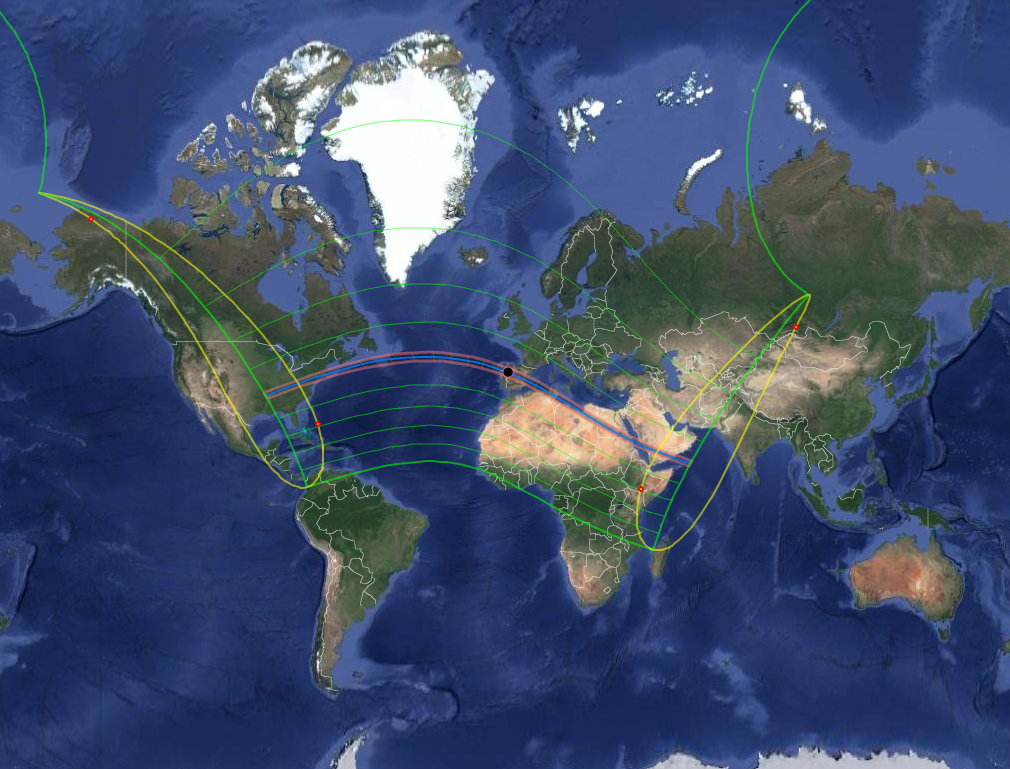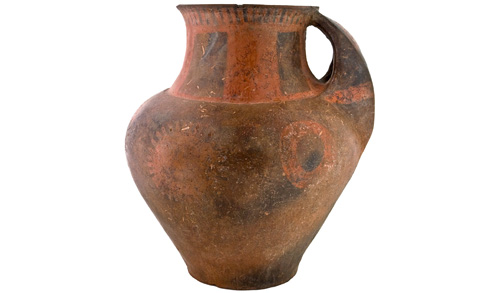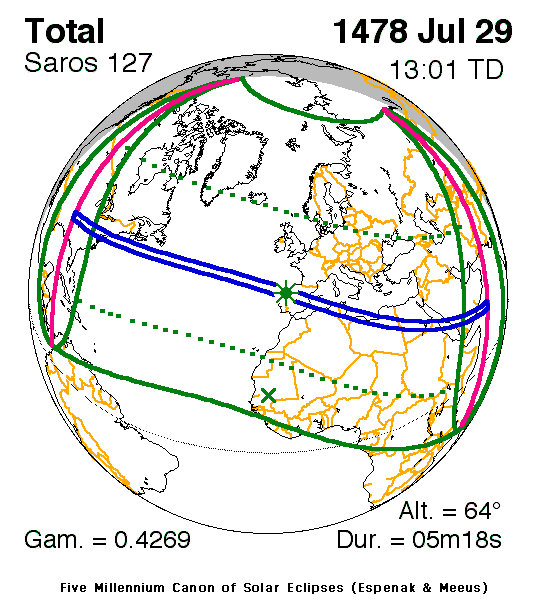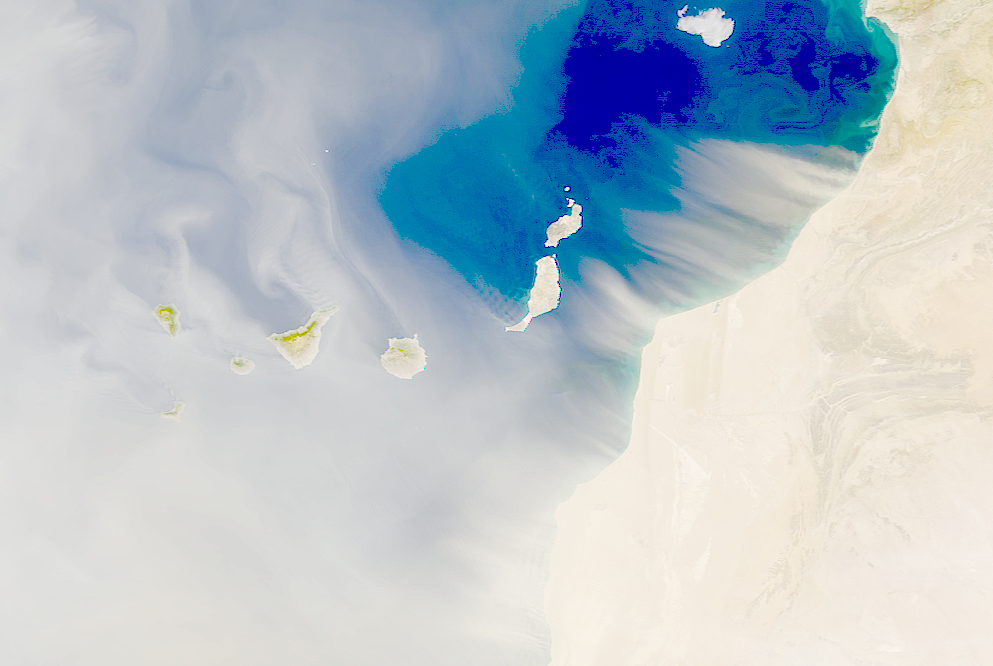
Visibility of the solar eclipse happened on July 29th, 1478. Yellow ovals determine the areas in which part of the eclipse took place below the horizon. The blue curve path “flies” over locations from where maximum occultation of the solar apparent surface could be observed (source: Xavier Jubier).
[…] They got into a fortress called the Ansita, which is in the parts of Tirajana. As the Governor knew it, he left with all the people on horseback and on foot that he could take, and went to the said fortress and surrounded it; and he had it surrounded in such a way they came to an agreement to save their lives and keep them from captivity and go to Castile, which were agreed. And the next day the faycán and the other Canarians came out of the fort, and brought them, and became Christians, on which day the Sun made a great eclipse, and afterwards it rained and a great wind blew; and over that island flew many birds that they had never seen before, which were cranes and storks and swallows, and many other birds they do not know their names.[1]MORALES (1978), p. 508. Translated and adapted from old Castilian by PROYECTO TARHA.
This curious passage, at the end of Chapter XXXVII in the Chronicle of the Catholic Monarchs written by Diego de Valera, shortly narrates the end of the conquest of Gran Canaria associating it with an astronomical phenomenon of undoubted transcendence for most of the ancient cultures: a total eclipse of the Sun.
Whether they were solar or lunar, we do not know if Canarian indigenes attributed beneficial properties to these phenomena, or if, on the contrary, they were interpreted as signs of misfortune. But it is out of question that eclipses were part of the islander iconography and have been studied in the context of the ancient history of the Archipelago by experts such as Professor José Barrios García, who ventures the possibility that certain rock representations, such as those preserved inside Cueva Pintada at Gáldar, served as calendars and, possibly, as calculation tools to forecast these exceptional events.[2]BARRIOS (2004), pp. 155-157.

Indigenous pitcher found at Agüimes (Gran Canaria), kept at El Museo Canario, catalogue number 260, featuring two shapes presumably depicting a sun and a solar eclipse (source: El Museo Canario).
Solar eclipses visible from the Canary Islands
Apart from the role played by eclipses in the almost-totally unknown indigenous cosmogony, it seems intuitive that, because of their greater spectacularity, solar ones should have occupied a preponderant place in it, and it is presumed that at least some of the successive expeditions and campaigns of Conquest undertaken by Europeans throughout the fifteenth century were possibly linked by ancient Canarians to these phenomena.
We may find comprehensive catalog prepared by Dr. Fred Espenak and Astronomer Jean Meeus, published by the NASA Goddard Space Flight Center, a very useful tool in order to find out the solar eclipses visible from the Canary Islands during that century. However, for the purpose of research carried out at a specific location, database developed by Astronomer Xavier Jubier, which is in turn based on the information provided by the previous catalog and the geographic coordinates we might provide through a web interface, allows us to quickly and automatically obtain visible eclipses over a certain time interval.
Querying previous database gives a total of forty sun eclipses visible from the Canary Islands between years 1401 and 1500. Many of them took place in hours close to sunrise or sunset, which in some cases would make them difficult to behold, not to mention any adverse weather condition at the time of the phenomenon, but at least ten of them would be perfectly sighted if this last impediment did not exist. Specifically, those of years 1431, 1438, 1448, 1453, 1462, 1470, 1478, 1481, 1485 and 1492.
A quick inspection allows us to link, more or less accurately, some of these years to outstanding events. For example, 1448 to Guillén Peraza’s death, 1470 to the intervention of Diogo da Silva in the Canary Islands, 1478 to the beginning of the royal conquest of Gran Canaria, 1481 to Doramas’ death and to the probable surrender of the Guanarteme or Faycan of Telde, and 1485 to the repression of the last indigenous rebellion in Gran Canaria, which in a way could be interpreted as a third claudicación of the Island resistance against the Castilian invaders.
It is tempting trying to identify eclipses that took place these last two years with that of the scene described by Diego de Valera. Nevertheless, it seems clear that, despite the manifest anachronism, this author refers to the total eclipse that was visible in the whole Iberian peninsula on July 29th, 1478, practically coinciding with the beginning of the royal conquest of Gran Canaria, such as has been pointed out by specialists such as Dr. José Juan Jiménez González.((JIMÉNEZ (1992), pp. 81-84)) However, we are going to make here some observations on the possible significance of these facts.

July 29th, 1478 solar eclipse astronomical data. Note that dotted curves approximately show locations where solar apparent surface occultation was of 50%, including the Canary Islands (fuente: Five Millennium Canon of Solar Eclipses – Espenak & Meeus)
A peculiar eclipse
As one might expect from such a remarkable event, Valera’s is not the only related testimony: Andrés Bernáldez, priest of Los Palacios, devotes chapter XXXIV of his History of the Catholic Monarchs to this phenomenon:[3]BERNÁLDEZ (1870, pp. 98-99). This translation by PROYECTO TARHA.
That said year of one thousand four hundred and seventy-eight, twenty-nine days of the month of July, Saint Martha’s day at noon, the Sun went into an eclipse, the most frightening that ever those who were born until then saw, as the Sun was completely covered and it stood black and the stars appeared as it were at night; which lasted jammed that way for a very long while, until been uncovered little by little, and people were in great fear, and they fled into the churches, and never again did the Sun return to its color, nor the day made clear as the days before it used to be, and so it became very hazy.
We have prepared two accelerated simulations of this solar eclipse seen from Sevilla and Real de Las Palmas –known at present as the city of Las Palmas de Gran Canaria–, respectively:
More than coincidence in the description of the astronomical phenomenon, the detail that both authors – Valera and Bernáldez – offer us about the meteorological phenomenon that accompanied this eclipse, is extremely interesting. We are spoken of rain and strong wind, and of a hazy atmosphere. These weather conditions are very familiar to us Canarians because they describe exactly what in the Archipelago we know as sirocco, sirocco-like weather or, more recently, southern weather.

Fragment of a fake-color satellite photo showing the sand storm that reached the Canary Islands on February 11th, 2011 (source: NASA Earth Observatory).
Although the prevailing winds in the Canary Islands are the trade winds, which blow from the Northeast, sometimes either East or Southeast air streams reach the Archipelago, coming from the nearby Sahara, loaded with particles of dust in suspension. These particles give the landscape a characteristically hazy appearance, and when its density is higher enough, due to the force of the wind, they can dye the sky of an orange or reddish color, making the direct observation of the Sun even bearable: the dusty haze. Under these conditions, environmental humidity, typical of the Archipelago’s subtropical weather, often suffers sudden drops giving way to intense rains, with drippings that precipitate the dust to the ground, especially in the case that the southern component of the wind happens to dominate, being then habitual that the haze reaches the Iberian peninsula producing the phenomenon described by the aforementioned chroniclers.
The Portuguese failure
So far, the scarce researchings carried out on this eclipse focuses on denying its relationship with the end of the conquest of Gran Canaria and transferring its eventual importance to the beginning of the royal conquest of this island. But it should be noted that the latter began, according to historiographical tradition, on June 24th, 1478, with the landing of Juan Rejón troops in the bay of Las Isletas and the foundation of Real de Las Palmas; that is, more than thirty days before the appearance of the eclipse. However, there is a milestone that we can precisely associate with the latter: the Portuguese attempt to expel the Castilians from Gran Canaria with the collaboration of the indigenes.
In fact, a few days after the Castilian landing, a Portuguese fleet, detached from another one sent abroad to abort the Spanish plans of conquest, landed in Agaete, northwest of the Island, and engaged in conversation with the Canarians agreed with them to launch a joint attack on the Castilian camp. Nevertheless, bad condition of the sea and the strong prevailing wind prevented the Lusitanians to land in Las Isletas, suffering numerous casualties in the attempt, part of them due to the resistance opposed by Rejón and his men.[4]Read, for example, MORALES (1978), pp. 127-129, and ABREU (1848), pp. 117-118.
It is obvious that, since the Bay of Las Isletas and Gando Roads are natural harbors where ships can anchor to take refuge from the trade winds, the fact that the Portuguese could not disembark in the former, due to the unfavorable conditions of sea and wind, clearly shows that the sailors faced that day a strong sirocco, and this is vividly narrated by chronicler Alonso de Palencia, without a doubt possessing information of first hand, who also gives us the date of the event:[5]MORALES (1978), pp. 480-481. This translation by PROYECTO TARHA.
In those lazy days of July —27th— under the sign of the Lion, the sea raged in such a way, precisely at the hours chosen by the enemy for the landing, that it barely allowed them to transfer themselves from the ships to the boats. Neither was it possible for the soldiers to hold their weapons tight nor prepare the guns against our own, keeping against the current of the sea in the sterns of the higher ships without serious danger.
This author ends his view of this story with the duration of the attempt:
The enemies, therefore, exhausted by the effort of attempting the landing in vain, left after five days, and the Canarians retreated to their hideouts.
None of the preserved ethnohistorical sources mentions the remarkable eclipse that occurred two days after the first attempt, while the Portuguese remained in the Canarian waters. Did the protagonists of these events come to watch it, despite the bad weather conditions? What was the interpretation that the ancient Canarians gave to this phenomenon? Did this influence on the definitive Lusitanian resignation upon landing? Let us take into account the superstitious psychology of seamen living in that time, as Palencia testifies when it comes to the clergymen:[6]MORALES (1978), p. 486. This translation by PROYECTO TARHA.
[Friars] are rejected and considered among military professionals as messengers of all the worst and sinister, while sailors do not admit them in their company because they attract storms and constitute signs of bad omen […]
References
- Abreu Galindo, Fr. J. de. (1848). Historia de la conquista de las siete islas de Gran Canaria. Santa Cruz de Tenerife: Imprenta, Lithografía y Librería Isleña
- Barrios García, J. (2004). Sistemas de numeración y calendarios de las poblaciones bereberes de Gran Canaria y Tenerife en los siglos XIV-XV. PhD. Thesis. La Laguna (Tenerife): Universidad de La Laguna
- Bernáldez, A. (1870). Historia de los Reyes Católicos D. Fernando y Doña Isabel escrita por el Bachiller Andrés Bernáldez, Cura que fué de la villa de los Palacios y capellán de D. Diego Deza, Arzobispo de Sevilla. Tomo I. Sevilla: Imprenta que fué de D. José María Geofrin

2 comments on “The solar eclipse of 1478”